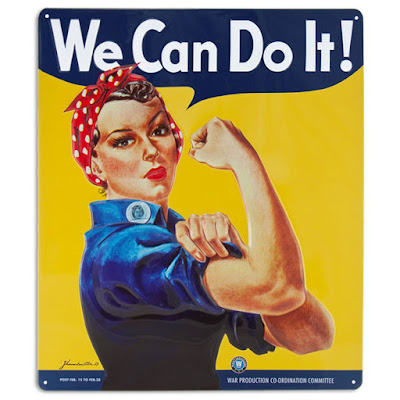‘Rosie The
Riveter’ Created A
Revolution For Working Women
By JIM
PURCELL
World War
II was a conflict where Americans bought into the need to support service
members and the military, perhaps more than ever before or since. A part of
that equation, in light of men joining and getting drafted into the armed
forces, was a first-of-its-kind campaign to recruit women into defense
production jobs.
 |
| "Rosie the Riveter" |
“Rosie the Riveter” was a symbol of that government campaign. She represented the American
working woman taking on manufacturing jobs traditionally held by men.
The government’s
Rosie the Riveter campaign took place between 1940 and 1945. Before the Rosie
campaign, ideas about women holding certain manufacturing jobs went against
societal and cultural norms of the day. In fact, this campaign, and the
resulting women in the workforce amounted to a sea-change for American women.
Prior to
World War II, approximately 27 percent of American women were working. Within a
few years of the Rosie campaign that percentage would increase to 37 percent.
And, by 1945, one out of every four married women were working outside the
home.
 |
| Women were recuited into defense jobs during World War II |
Overall, women
were a notable presence throughout defense manufacturing. However, the aircraft
industry saw the greatest rise in female employment, with 310,000 women
employed by 1943. Within the aircraft industry, this amounted to 65 percent of
the total workforce. This was a remarkable increase, considering that, before
the war, women only numbered one percent of the aviation industry.
So, was
there a real Rosie the Riveter? Yes and no. The Rosie campaign was based, in
small part, on the life of a real munitions worker. But, Rosie was primarily a
work of fiction. However, this iconic character, clad in work clothes with a
red bandana on her head could be found in movies, newspapers, posters,
photographs and articles. Part of Rosie’s mission was to appeal to the
patriotic natures of America’s women.
Yet, even
though America’s women showed up to the workplace during the war, not
everything changed. The pay for women lagged and female workers rarely ever
made more than half of what a man might for the same job.
 |
| During the war, 19 million women went to work |
During the
war, nearly 19 million women held jobs. Many of these women were previously
working before the war, but for less than they would during the war. There were
also women who returned to the workforce during the war.
A problem
occurred after the war, though. The government had done everything it could to
recruit women into jobs traditionally held by men. However, there was the
expectation (at least on the part of men), that women would return to working
in the home at the end of the war. Of course, the horizons of many women were broadened
by this experience and many did not wish to return to being homemakers.
In a very
real way, the Rosie campaign triggered a post-war revolution for women in the
workplace. Though the problems of inequality would be a perpetual problem for
women, the bell had been rung. And, once rung, could not be ‘un-rung’ by men
returning from the war.
Women
taking their rightful place in the workforce didn’t happen all at once after
World War II. Immediately after the end of the war, female employment fell
drastically, from 37 percent down to 26 percent. Women had to fight for their
place in the workforce after World War II, even up to today in some ways. The
Rosie campaign can at least be given some credit for changing attitudes in
America.
Of special
note in the saga of Rosie the Riveter is Elinor Otto. She took a job in the
aircraft industry and built airplanes for 50 years afterward. Eventually, Ms.
Otto retired at the age of 95 years old, earning her the reputation as the “Last
Rosie the Riveter.”
No comments:
Post a Comment
No profanity, vulgar language, personal attacks, libel or defamation, nudity of any kind or sexual imagery is permitted on this site. The site's management reserves the right to screen all messages for appropriateness through this venue.